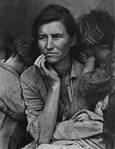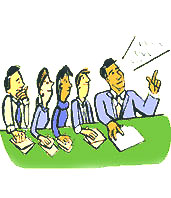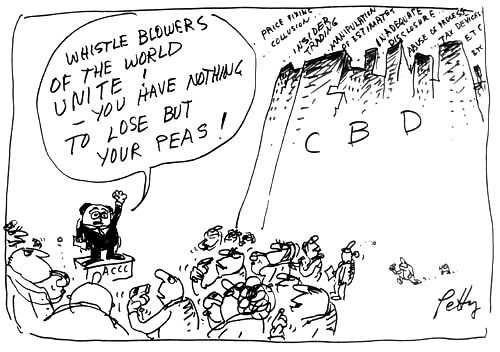


Key Words
fairness
race and ethnicity
Key Words
racism
ethnicity
discrimination
2.1 We start with race and ethnicity in this module. You will see that
this issue cannot be separated for long from the wider topic of inequality.
2.1 Read the transcript from the ABC News program This week with David Brinkley
on racism (1990). Notice the conclusion on page 2.5 that the old civil rights ethic of "all for
one and one for all" now seems to be lost. Instead, many people now dwell on and celebrate ethnic
and racial differences.
2.6 Notice the problems in defining racism. Some deny the very notion of "race". There are
also many different approaches to racism. Some people want to emphasise the discreteness of races
and celebrate distinctiveness. Others argue that, like sexism, racism is a practice of the dominant
and of the powerful.
The problem of affirmative action and positive discrimination is also noted.
If racist practices are defined as those in which a person is discriminated against on a race
membership basis thaen it seems that both affirmative action and positive discrimination are
forms of racism. We will spend some time on this problem in class.
Notice that the definition of racism as "skin discrimination" is superficial and does not really get to the root
of the problem.
2.7 Ruth Benedict (also famous for her writings on Japan such as Chrysantemum and the Sword )
in her classic Race and Racism defines racism has "the dogma that one ethnic group is
condemned by nature to congenital inferiority and another group to congenital superiority."
Racists think that the "lowest" member of their preferred racial group is worthy of respect before
the "highest" member of the relegated race.
2.8 notice the impact of Charles Darwin & his friend Herbert Spencer. Spencer's social
Darwinism is often regarded as a distortion of Darwin's teachings.
2.9 notice that virtually all post Enlightenment humanist conceptions of progress, development and
modernisation (including those of Marx and John Dewey) have had a "graded" conception of human
cultures.
Racism, then, is much more than a question of skin color; it has much to do with culture.
Notice the definitions of chauvinism (ショービニスム) and xenophobia given on this page. What is the
difference?
sexism & gender (course packet 2.14 - 2.30)
Key Words
2.14 How do we define sexual harassment?
2.19 think about the issue of institutional sexism. Do, and if so how much, do places such as the
military or even universities institutionalize sexism? Many institutions have "cultures" that were
established with just men in mind.
2.20 think about the language we use. For example a man may be called "assertive" whereas a
women is described as "aggressive". Think of words in English that describe women as children or
as "babies".
2.21 sex discrimination involves treating people differently only because of their gender.
There is overt or "straight out" discrimination and what is known as covert
or "glass ceiling" discrimination in the work place.
2.23 a number of different approaches have been taken to the problem of sexism. Notice the liberal
view that tends to minimise gender difference. On the other hand, notice other views that
recognise gender difference and continue to talk in terms of gender priorities and ways of doing
things differently without reproducing sexist attitudes. We sometimes see a similar "equal but
different" approach in the race and culture field. Is such an approach possible or good?
Women have historically supposed to be inferior because of their presumed incapacity to appreciate
that all questions of justice require the disinterested application of universal principles - women
have been though to "get too involved"
2.24 ideas about the moral incapacity of women were used to deny women the right to vote. With the
only one the right to vote in Australia in 1902, in the United States in 1920 and in the United
Kingdom in 1928.
Notice the further discussion of the glass ceiling.
poverty, juvenile crime & the media (course packet 2.31 - 2.59)
Key Words
juvenile
crime
media
stigma
deserts
pathology
genetic
familial
3.31 The ABC News Nightline program define the problem using Bill
Clinton's words: everybody agrees that welfare should be
a second chance, not a way of life but everybody wants to make sure that innocent people
(especially children) are not allowed to suffer.
The how can we help others without creating bad habits and dependency? Where do we draw the line?
2.36 when the poor are supported poor people are liable to be morally blamed.
What does the word mean?
How did policies distinguish between the deserving and the undeserving poor?
What is the difference between "unavoidable misfortune" and carelessness/laziness?
2.37 What are the 3 ways in which "poverty" is usually classified?
What are the differences between pathological causes (poverty caused by personal inadequacies such
as laziness) genetic causes and familial causes?
What is meant by the phrase culture of poverty?
2.38 structural explanations attribute poverty to the society in which poverty takes place rather
than to individuals who experience poverty. Poverty is also represented by some as a product of a
class, status or power.
What are the six responses to poverty that are listed on pages 2.38 and 2.39? In which situations
should we use each of these responses to poverty?
Why does the criminal law treat young people differently from older adults?
What are the "three models of criminal justice" listed on pages 2.40 through 2.42?
2.42 Why can we not rely totally on the legal system to solve the "crime problem"?
What factors are listed at the bottom of 2.42 as clauses of crime?
What suggestions does the writer of this article make concerning juvenile crime? Do you agree?
State your reasons
leadership (course packet 2.69 - 2.77)
2 What three things did Thomas Aquinas think we should consider when we are trying to judge
whether an action is ethical ?
3 What motivates an egotistic person?
4 What motivates an altruistic person?
5 Which type of person (egotistic or altruistic) makes a real leader? and why?
6 Explain the transactional mode of treating followers.
7 Explain the transformational mode of treating followers.
8 Why is the transformational way of treating followers better than the transactional way?
equality
平等 【びょうどう】 (adj-na,n) equality (a); impartiality; evenness;
一律 【いちりつ】 (adj-na,n-adv,n) evenness; uniformity; monotony; equality
平手 【ひらて】 (n) palm; equality
平等権 【びょうどうけん】 (n) right of equality
平等主義 【びょうどうしゅぎ】 principle of equality
均一 【きんいつ】 (adj-na,n) uniformity; equality;
同格 【どうかく】 (adj-na,n) the same rank; equality; apposition
同等 【どうとう】 (adj-na,adj-no,n) equality; equal; same rights; same rank;
中正 【ちゅうせい】 (adj-na,n) impartiality; fairness
同一 【どういつ】 (adj-na,adj-no,n) identity; sameness; similarity; equality; fairness;
不偏 【ふへん】 (adj-na,n) impartiality; neutrality; fairness;
公平 【こうへい】 (adj-na,n) fairness; impartial; justice;
公正 【こうせい】 (adj-na,n) justice; fairness; impartiality;
公明正大 【こうめいせいだい】 (adj-na,n) fairness; just and upright; aboveboard
正大 【せいだい】 (adj-na,n) fairness; justice
公明 【こうめい】 (adj-na,n) fairness; justice;
(course packet 2.1 - 2.18)

race
人種 【じんしゅ】 (n) race (of people)
レイシズム racism
エスニシティ ethnicity
女性差別 【じょせいさべつ】 discrimination against women; sexism
差別表現 【さべつひょうげん】 (n) word, phrase, or image that is perceived as
showing or suggesting discrimination or prejudice against a person or group of people
見境 【みさかい】 (n) distinction; discrimination
人種差別 【じんしゅさべつ】 racial discrimination
判別 【はんべつ】 (n,vs) distinction; discrimination
被差別 【ひさべつ】 discrimination
分かち 【わかち】 (n) distinction; differentiation; discrimination
分け隔て 【わけへだて】 (n) discrimination
Macquarie Dictionary defines racism as:
1. the belief that human races have distinctive characteristics which determine their respective
cultures, usually involving the idea that one's own race is superior and has the right to rule or
dominate others.
2. offensive or aggressive behaviour to members of another race stemming from such a belief.
flirt
[女と戯れる 【おんなとたわむれる】 to
flirt with a woman
乳繰り合う 【ちちくりあう】 (v5u) to flirt with one another; to caress amorously
戯れる 【じゃれる】 (v1) to be playful; to gambol; to be amused (with something); to play; to
sport; to frolic; to joke; to flirt with
戯れる 【ざれる】 (v1) to be playful; to gambol; to be amused (with something); to play; to sport;
to frolic; to joke; to flirt with
戯れる 【たわむれる】 (v1) to be playful; to gambol; to be amused (with something); to play;
to sport; to frolic; to joke; to flirt with;
媚びる 【こびる】 (v1) to flatter; to curry favor with; to flirt with; to fawn on
巫山戯る 【ふざける】 (v1) to romp; to gambol; to frolic; to joke; to make fun of; to flirt

How do you draw the line between an innocent "flirt" and "harassment"?
The sexual harassment charges against Clarence Thomas reignited a debate in the
United States over this issue. Justice Clarence Thomas was confirmed by the Senate as the second
African-American member of the Supreme Court on October 15, 1991. The allegations were
brought by Anita Hill, an African-American woman and a Yale Law School graduate who worked for
Thomas at the Equal Employment Opportunity Commission (EEOC). For three days, in nationally
televised hearings, Hill accused Thomas of sexually harassing her. Thomas denied her charges.
The confirmation vote of 52-48 was the closest vote this century.


poverty
金欠病 【きんけつびょう】 (n) poverty
赤貧 【せきひん】 (n) extreme poverty
貧 【びん】 (n,vs) poverty; becoming poor; living in poverty
貧しく暮らす 【まずしくくらす】 to live in poverty
少年審判所 【しょうねんしんぱんじょ】 juvenile court
少年犯罪 【しょうねんはんざい】 juvenile delinquency
不良少年 【ふりょうしょうねん】 juvenile delinquent
少年法 【しょうねんほう】 (n) juvenile law
犯罪 【はんざい】 (n) crime
事犯 【じはん】 (n) crime
罪を犯す 【つみをおかす】 (exp) to commit a crime
重い罪 【おもいつみ】 serious (grave) crime
連坐 【れんざ】 (n,vs) implicated (involved) in (a crime)
強力犯 【ごうりきはん】 (n) violent crime
犯罪発生率 【はんざいはっせいりつ】 crime rate
収賄罪 【しゅうわいざい】 (n) (the crime of) bribery
受託収賄罪 【じゅたくしゅうわいざい】 (the crime of) bribery
殺人罪 【さつじんざい】 (n) (the crime of) murder
媒体 【ばいたい】 (n) media
報道機関 【ほうどうきかん】 information media; press; news organs
印刷媒体 【いんさつばいたい】 print media
広告媒体 【こうこくばいたい】 advertising media
電子メディア 【でんしメディア】 (n) electronic media
ニュース媒体 【ニュースばいたい】 news media
マスメディア (n) mass media
メディア (n) media
烙印 【らくいん】 (n) mark; brand; stigma; branding iron
自業自得 【じごうじとく】 (adj-na,exp,n) paying for one's mistakes; getting one's just deserts;
suffering the consequences (of one's own actions); reap what you sow
身から出た錆 【みからでたさび】 (exp) paying for one's mistakes; getting one's just deserts;
suffering the consequences (of one's own actions); reap what you sow
病理 【びょうり】 (n) pathology
病理学 【びょうりがく】 (n) pathology
臨床 【りんしょう】 (n) clinical pathology
ジェネティック genetic
体質 【たいしつ】 (n) constitution (physical); genetic make-up; predisposition (to disease
遺伝地図 【いでんちず】 genetic map
ジェネティックシステム genetic system
遺伝病 【いでんびょう】 (n) hereditary (genetic) disease
家庭的 【かていてき】 (adj-na,n) family-oriented; familial

1 Purpose - leaders should look at the status quo and question what needs to be changed for the good of the
institution and the wider community if.
2 Pride - the moral leader needs to have high self esteem -
a healthy pride but not vanity!
3 Patience - the leader must realise it takes time and effort to
overcome obstacles necessary to achieve good goals.
4 Persistence - a good leader should never give
up - this does not mean that we should be stubborn. Leaders should not attempt the impossible on
small points (they should not "sweat the small stuff") but the leader should always stay on
course towards the goal of moral leadership.
5 Perspective - prospective is seeing what is really
important in a given situation (remember Aquinas)

TASK
1 A leader should try to do two things. A leader should try to achieve organizational goals.
But what is the other (more important) thing that a leader should try to do?

cartoon © The Age newspaper and Petty